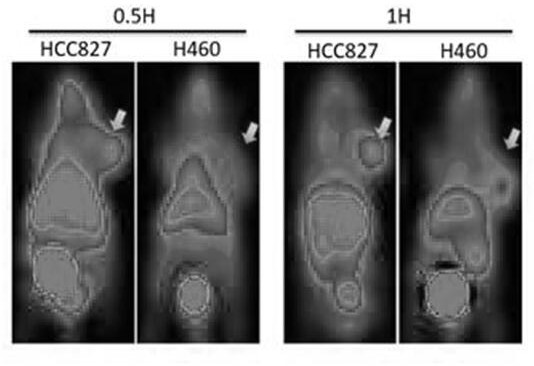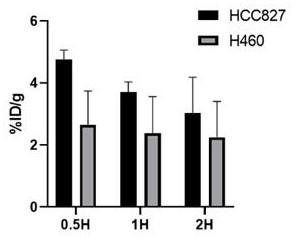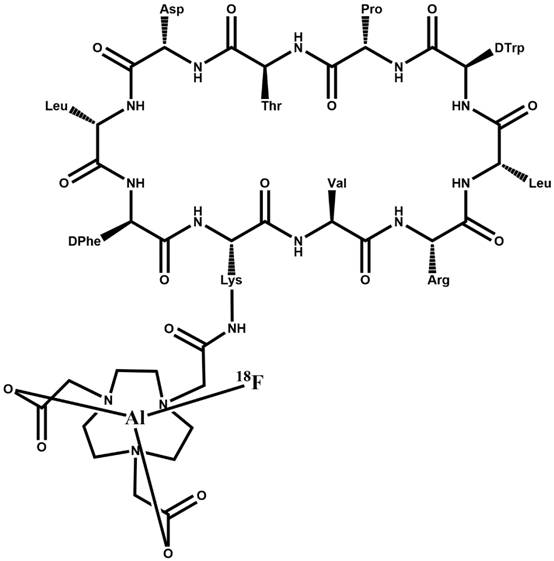PD-L1-targeting polypeptide PET molecular imaging probe as well as preparation method and application thereof
A technology of PD-L1 and molecular imaging, applied in the fields of radiopharmaceutical chemistry and clinical nuclear medicine, to achieve rapid metabolism and excellent in vivo targeting performance
- Summary
- Abstract
- Description
- Claims
- Application Information
AI Technical Summary
Problems solved by technology
Method used
Image
Examples
Embodiment 1
1) Preparation of NOTA-PA2881: 1. Dissolve 5 mg Cyclopeptide 66 in HEPES-EDTA solution, add 3 equivalents of triisopropylacetamide (2-carboxyethyl) phosphine (dissolved in 0.2 mol / L) ammonium acetate buffer, pH=7), evacuated the gas in the solution, repeated three times; reacted at room temperature for 60 minutes, then transferred to a centrifugal filter, centrifuged at 4000 rpm for 90 minutes; 1 mL of 0.2 mol / L ammonium acetate buffer The reduced peptide was added to 2 mL of 0.2 mol / L ammonium acetate buffer (pH=7) and transferred to the second reaction vessel; 4 mg of NOTA-maleimide and 0.5 mL of 0.2 mol / L The sodium acetate buffer (pH=7) was mixed and added to the second reaction vessel, and reacted at 40 °C for 3 hours; after the reaction was completed, the reaction mixture was transferred to a centrifugal filter, and centrifuged at 4000 rpm for 90 minutes; after discarding the flow , add 2 mL of ultrapure water, centrifuge again at 4000 r / min for 90 minutes, and discard th...
Embodiment 2
probe 18 In vivo targeting validation of F-AlF-NOTA-PA2881.
[0037] In the in vivo targeting validation experiment, the cell line HCC827 with high PD-L1 expression and the cell line H460 with low PD-L1 expression were used to establish a nude mouse tumor model (female mouse, 5 weeks old, about 20 g, 2 × 10 6 The number of cells was subcutaneously implanted on the right shoulder, and the tumor volume was about 300mm after about 4 weeks 3 in vivo imaging experiments), injected via mouse tail 18 After F-AlF-NOTA-PA2881 probe solution (injection dose is 9.25MBq, 150 μL), 0.5 hour, 1 hour PET / CT scan (Discovery 790Elite, GE healthcare) was performed under isoflurane-oxygen anesthesia. The duration is 5 minutes, and the image post-processing platform AW4.6 software (GE Healthcare).
[0038] Imaging results such as figure 1 , HCC827 tumor uptake probe was significantly higher than background and significantly higher than H460, indicating that the probe 18 F-AlF-NOTA-PA2881 can s...
PUM
 Login to view more
Login to view more Abstract
Description
Claims
Application Information
 Login to view more
Login to view more - R&D Engineer
- R&D Manager
- IP Professional
- Industry Leading Data Capabilities
- Powerful AI technology
- Patent DNA Extraction
Browse by: Latest US Patents, China's latest patents, Technical Efficacy Thesaurus, Application Domain, Technology Topic.
© 2024 PatSnap. All rights reserved.Legal|Privacy policy|Modern Slavery Act Transparency Statement|Sitemap



